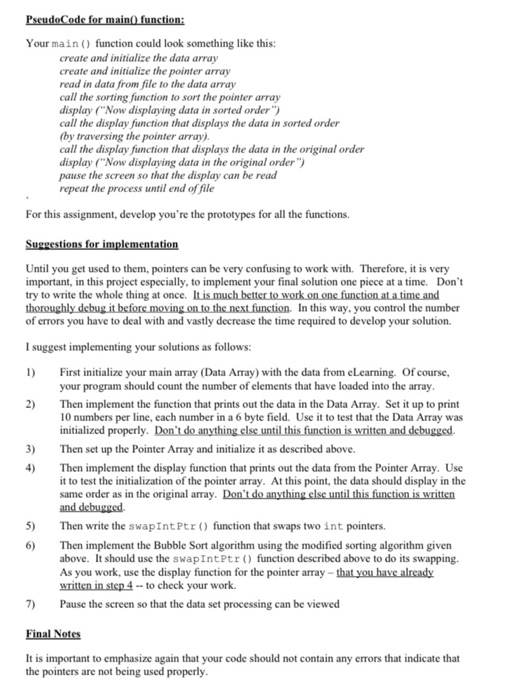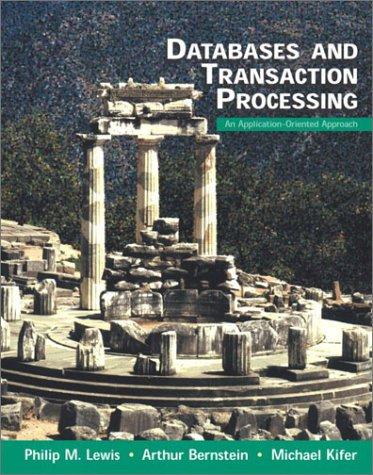Question
IN C++ Sometimes were given an array of data that we need to be able to view in sorted order while leaving the original order
IN C++ Sometimes were given an array of data that we need to be able to view in sorted order while leaving the original order unchanged. In such cases we could sort the data set, but then we would lose the information contained in the original order.
One solution might be to create a duplicate of the data set, perhaps make a copy of one array into another, and then to sort the second array. This would allow us to view the data both in the original order and in the sorted order. This might be fine in many cases, but if the data set is large and memory limited (say, perhaps, in an embedded system), this solution might not be practical.
A more elegant solution is to sort the array indirectly, i.e., by using pointers. With this technique we wouldnt change the positions of the actual data items in the array; we would only change the values of the pointers in another array that has pointers into the original data array. When this type of sorting is performed on the array that containers the pointers , we still will be able to access the data both in its original order in the original array and using the array of pointers that is in sorted order.
: Here is depicted the original data set contained in the array on the right in each picture, and an array of pointers pointing at various elements of the original data set on the left in each picture. We first initialize the array of pointers so that each element in the pointer array points to the element in the data array that has the same index value (left hand picture). We then sort the array of pointers according to the values they point to, leaving the original data set untouched (right hand picture). After this step is completed, we can access the data set in its original order by using the original array, or we can access the data set in sorted order through the pointer array.
Input
For our input into this problem lets use a text data file named arrayData.txt. This file will contain a several space delimited horizontal list of integers. Each list will be preceded by a line that contains a number that will indicate the number of elements in the following horizontal list. The largest a list can be is 10 items. Your data file should contain at least 5 lists.
You do not have to check the data file for validity and can assume the file contains all correct information. Your program should read this data into an array using the File I/O techniques already discussed.
Sorting
There are many common sorting algorithms that could be used to sort this data. Most of these are whats known as comparison based sorting algorithms, since they make decisions by comparing each array element against others. Most often, comparison based sorting algorithms work by interchanging, or swapping, elements within the array.
You can use any of the O(n2 ) sorts that you wish to sort the pointer array.
One common and simple O(n2 ) sort algorithm is called - Bubble Sort. It works by making multiple passes through the data set and on each pass comparing two adjacent array elements and swapping them if the right hand element is less than the left hand element. In this way, the largest element remaining is bubbled to the top of the array on each pass. After all the passes are completed, the array is in sorted order.
Here is the pseudo-code for one version of the Bubble Sort. This is an O(n2 ) algorithm that is based on two nested loops: outer loop index i runs from n-1 down to 1 (inclusive)
o inner loop index j runs from 0 to i-1 (inclusive)
compare array[j] and array[j+1]
swap if array[j] > array[j+1]
Here, n refers to the size of the data set. As written, this algorithm will swap array elements until the data set is sorted. (Note that it is necessary to swap two values in the last line.) In our implementation, however, we will swap the pointers that point to those array elements, while leaving the array elements themselves untouched. This should be done with a swapIntPtr() function as described below.
As given, this algorithm would sort the original array of ints very well. However, as mentioned, it does so by changing the values in the original array. In this assignment, we need to be able to sort the pointer array instead of the original int array. Although the sorting should be done according to the values the pointer array is pointing to, the only values actually changed are pointers. Therefore, this algorithm will have to be modified to work on the pointer array.
Swap Function
We will need a swap function that can swap the values of two argument pointers. In this case, our original data set consists of all ints. Therefore, the swap function needs to be able to swap pointers to ints. The name of the function must be swapIntPtr().
What should the parameters for the swapIntPtr() function be?
Displaying Data
We will display the data both in sorted form and in unsorted form. The data should be displayed 10 numbers per line, each number in a 6 space field. Functions should be used to display the data.
Note that the display function that displays the data in the original array must be different than the display function that displays the data through the pointer array. Thus, this operation will require two different functions. Each will have a different set of parameters.
Project Requirements (Overview)
This is a high level outline of what needs to be accomplished in this assignment:
1) Get the data from the file into an array.
2) Assign a pointer array of int pointers of the same size as the data array. Initialize it to point to the Data Array in such a way that, after being initialized, each element of the Pointer Array should point to the element in Data Array that has the same index. (This is illustrated in the first picture above.)
3) Sort the Pointer Array by using a modified version of the Bubble Sort algorithm provided. After sorting, pointerArr[0] should point to the smallest element in Data Array, pointerArr[1] should point to the second smallest element, and so forth.
4) Your program should print out the data set 2 different times for each number list. First, print the sorted number list by traversing the pointer array.
5) Repeat step 1 until there is not any more data in the file.
Functional Requirements:
You will need to write the following functions besides main():
1. ReadIntoDataArray()
Read the data from the file into the data array.
2. A SwapIntPtr() function.
3. When called on two pointer arguments, this function should swap the values of the pointer arguments.
4. A sorting function.
This function should implement the Bubble Sort (or some other common sorting algorithm) on the Pointer Array. Note that we are not sorting the Data Array in this problem, only the Pointer Array. Therefore, the pseudocode for the Bubble Sort given above will have to be modified to work on pointers. Furthermore, the sorting will be done according to the values the pointers are pointing to.
Referring back to Bubble Sort, if we are comparing the values pointed to in one adjacent pointer element to another, and the value pointed to is smaller in the right hand element than the left, then we swap the pointers, not the values in the Data Array. 5. A display function for the Data Array.
6. This function should display the data in the Data Array, 10 numbers per line in a 6 space field.
7. A display function for the Pointer Array.
This function should display the data pointed to in the Pointer Array, 10 numbers per line in a 6 byte field. Note that this function does not display addresses. It should display the integers found in the data set, but in sorted order.
8. Repeat the process until there is not any data left in the field.
: Suggestions for implementation
Until you get used to them, pointers can be very confusing to work with. Therefore, it is very important, in this project especially, to implement your final solution one piece at a time. Dont try to write the whole thing at once. It is much better to work on one function at a time and thoroughly debug it before moving on to the next function. In this way, you control the number of errors you have to deal with and vastly decrease the time required to develop your solution.
I suggest implementing your solutions as follows:
1) First initialize your main array (Data Array) with the data from eLearning. Of course, your program should count the number of elements that have loaded into the array. 2) Then implement the function that prints out the data in the Data Array. Set it up to print 10 numbers per line, each number in a 6 byte field. Use it to test that the Data Array was initialized properly. Dont do anything else until this function is written and debugged. 3) Then set up the Pointer Array and initialize it as described above. 4) Then implement the display function that prints out the data from the Pointer Array. Use it to test the initialization of the pointer array. At this point, the data should display in the same order as in the original array. Dont do anything else until this function is written and debugged. 5) Then write the swapIntPtr() function that swaps two int pointers. 6) Then implement the Bubble Sort algorithm using the modified sorting algorithm given above. It should use the swapIntPtr() function described above to do its swapping. As you work, use the display function for the pointer array that you have already written in step 4 -- to check your work. 7) Pause the screen so that the data set processing can be viewed
Final Notes
It is important to emphasize again that your code should not contain any errors that indicate that the pointers are not being used properly.

Step by Step Solution
There are 3 Steps involved in it
Step: 1

Get Instant Access to Expert-Tailored Solutions
See step-by-step solutions with expert insights and AI powered tools for academic success
Step: 2

Step: 3

Ace Your Homework with AI
Get the answers you need in no time with our AI-driven, step-by-step assistance
Get Started


